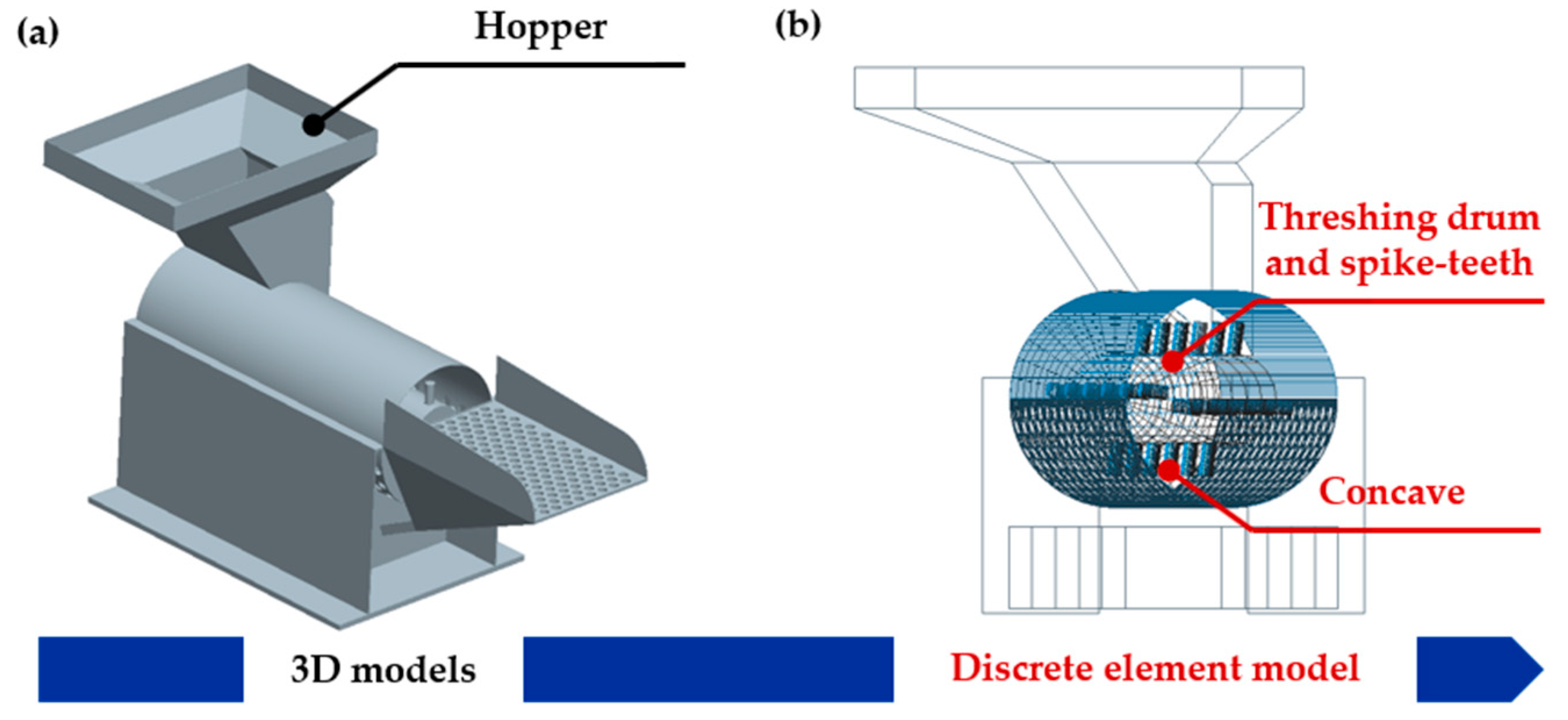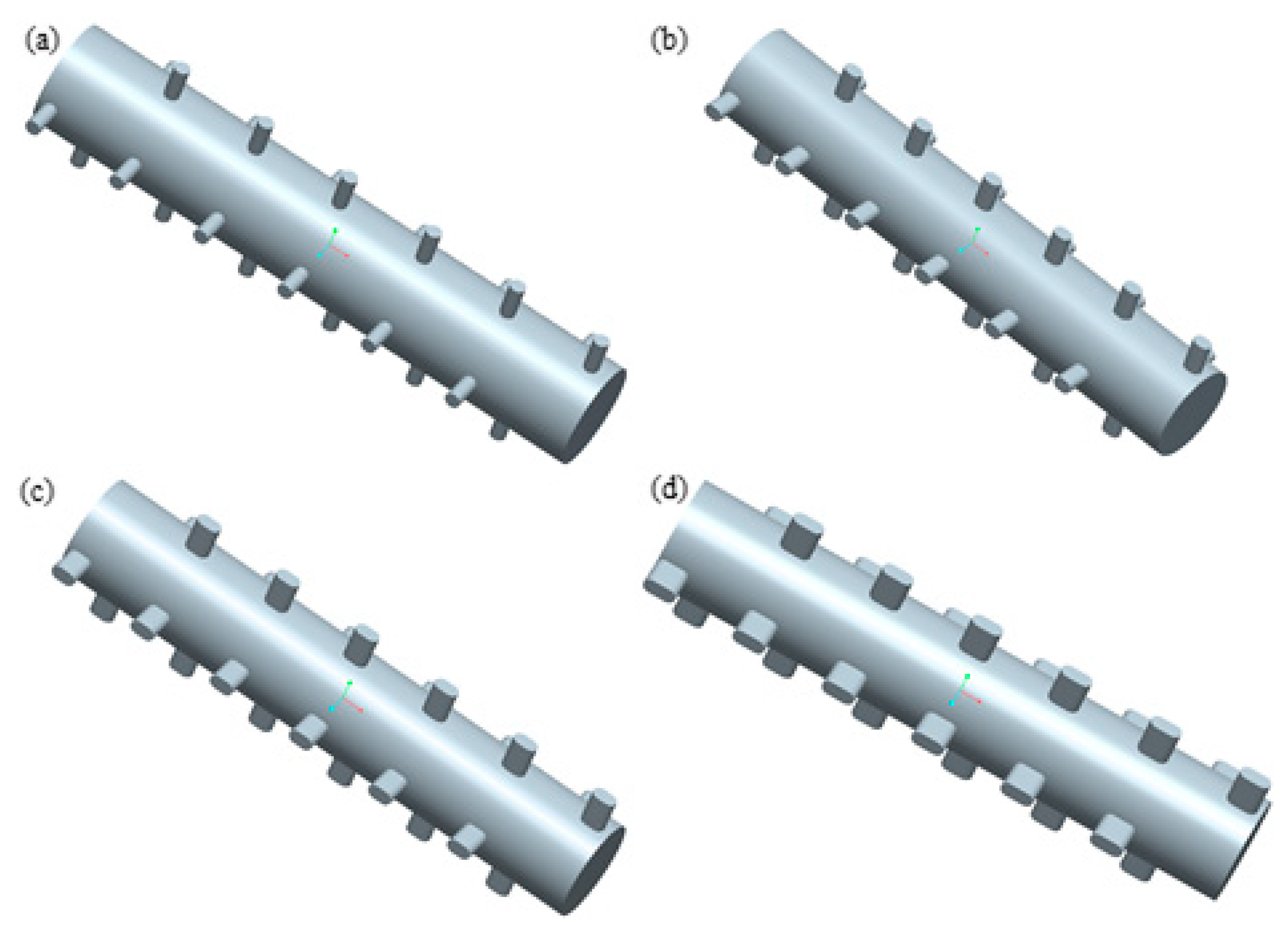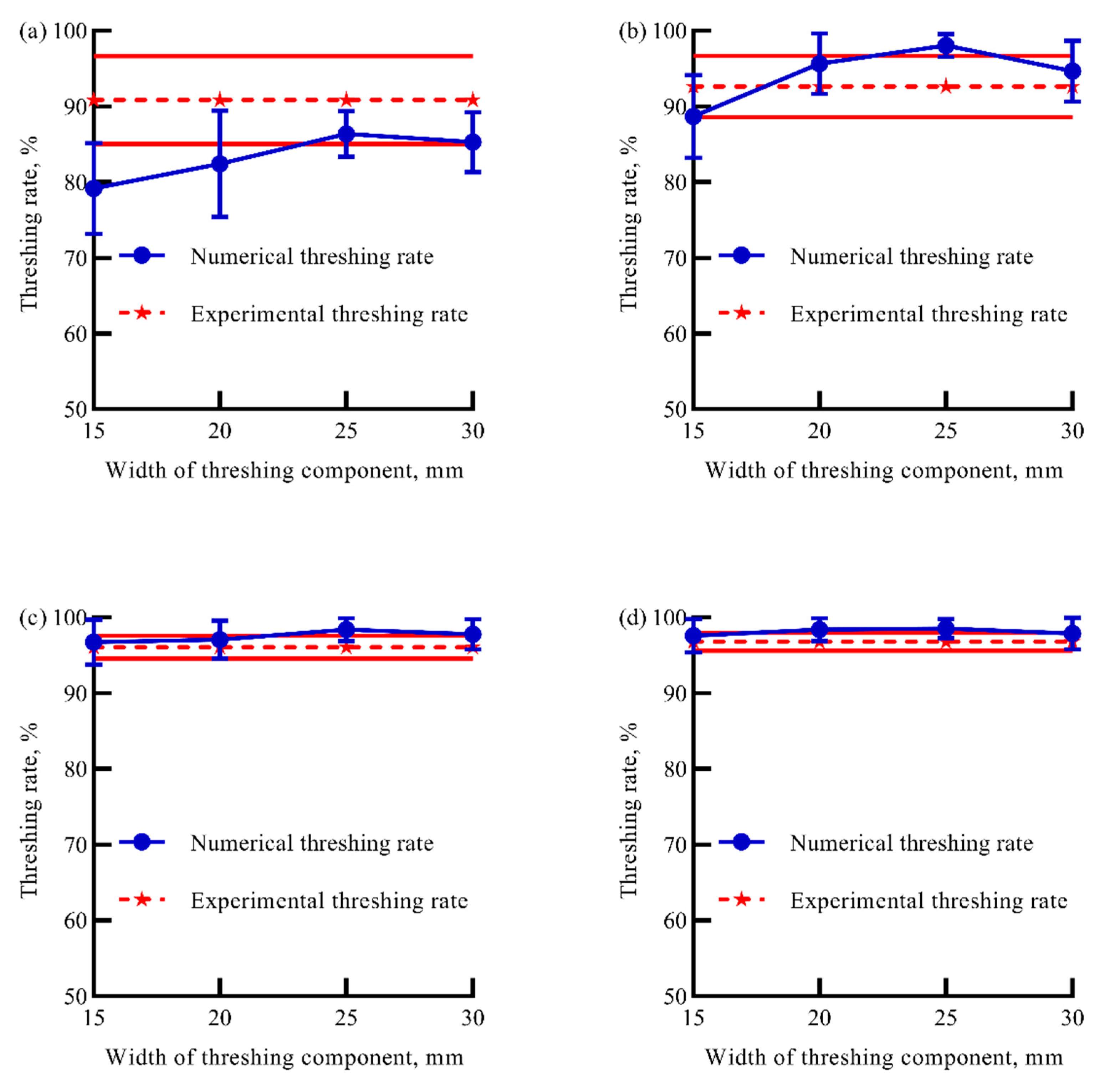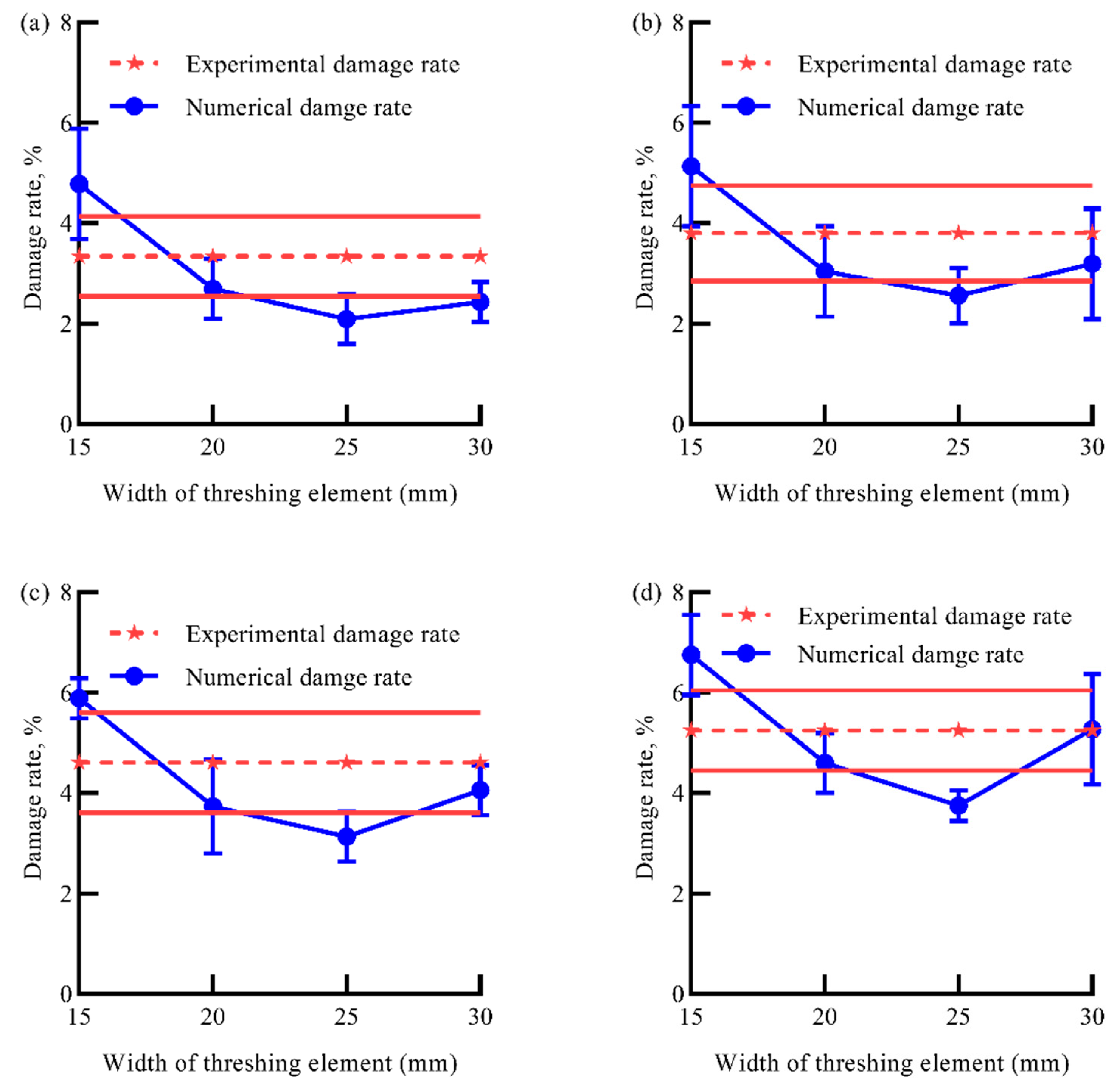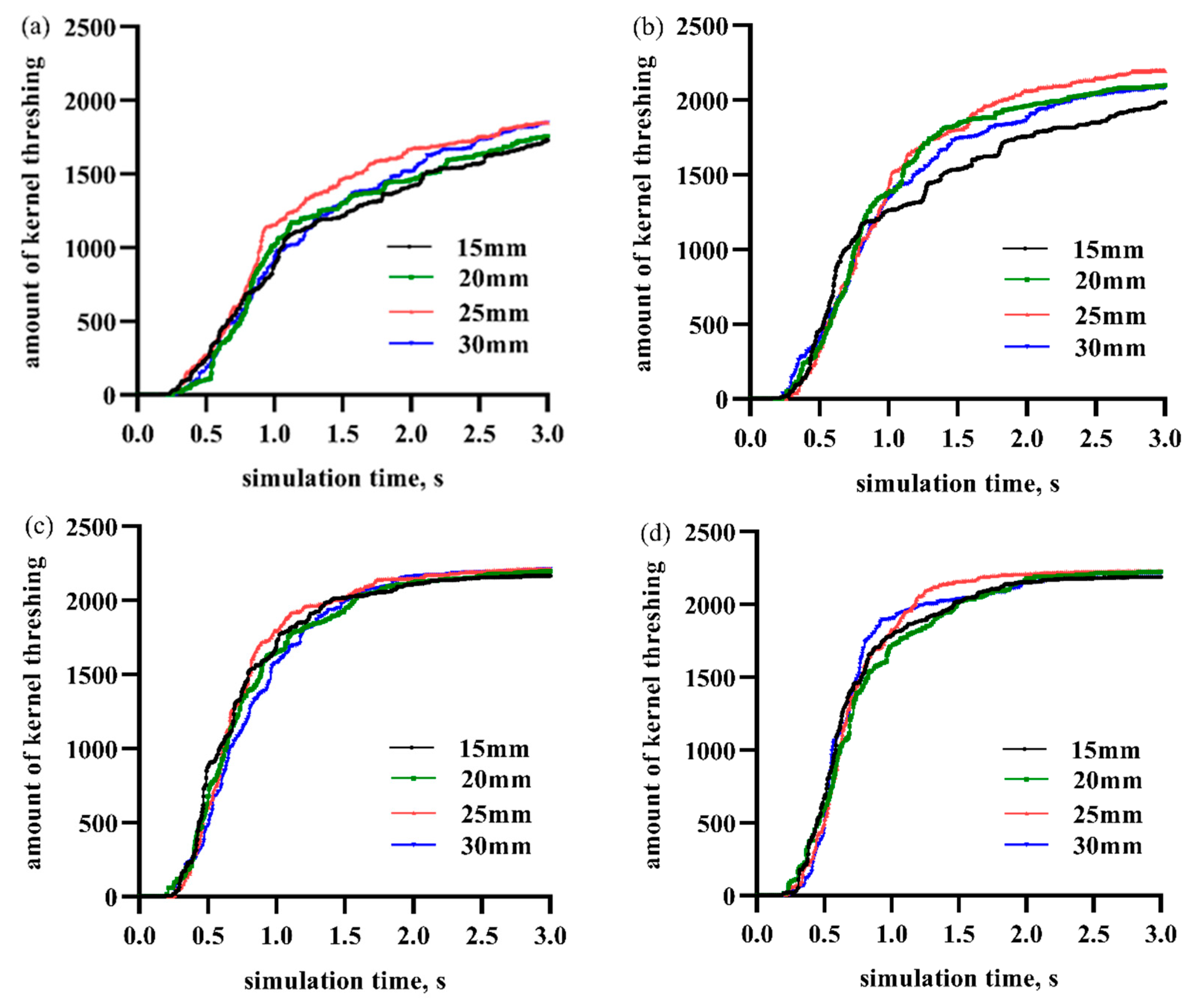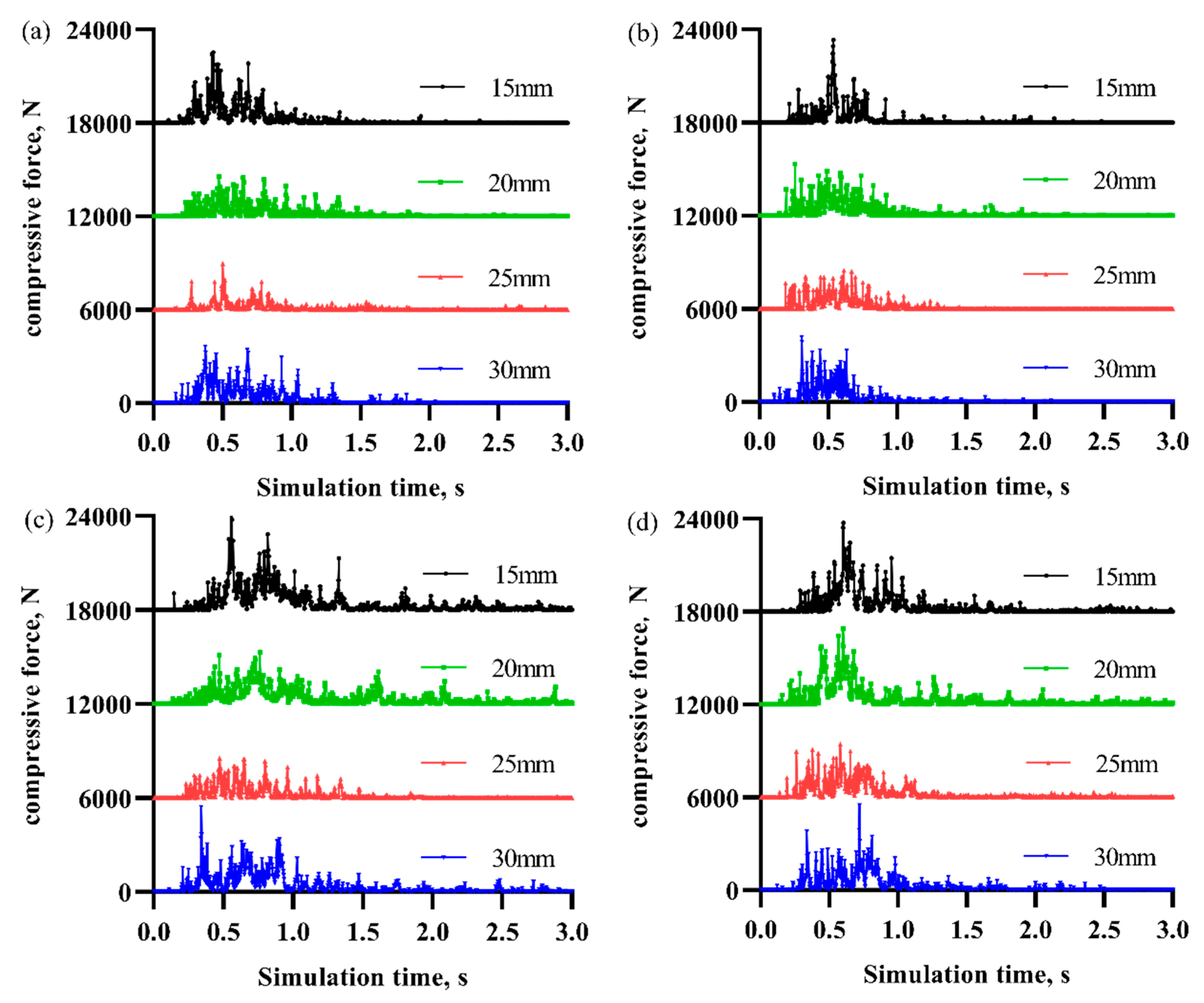1. Introduction
By revealing the law of influence of the core parameters of corn threshing elements on the kernel threshing and damage rates [
1,
2], it becomes a prerequisite and key to improve the quality of corn threshing operations [
3,
4]. The standard of corn kernel threshing rate and damage rate is 90% and 6% respectively (national industry standard of PRC). Corn threshing operation is a central part of corn production [
5,
6], and the operation quality directly determines corn yield and quality [
7]. The core parameters of the threshing element are the contact width and the rotational speed [
8,
9], respectively, both of which determine the kinetic state of the corn kernels during threshing [
10,
11]. Therefore, if the quality of corn threshing operation is to be improved, the optimal combination of design parameter values for corn threshing elements needs to be optimized.
How to achieve accurate observation and analysis of the kinetic state of the corn kernel population during the threshing process is the central difficulty in the optimal design of corn threshing element parameters [
12]. Currently, researchers commonly use empirical, experimental and analytical methods to study the kinetic state of corn kernels [
13,
14]. The aforementioned methods rely on a large number of tests and require processing of threshing elements with multiple parameters, which is too costly in terms of time and economy [
15,
16]. At the meantime, tests can only be conducted within a week of corn kernel maturity [
17,
18,
19], making the test period too short for large-scale replication. Therefore, in recent years, researchers have begun to explore high-precision discrete element numerical simulation methods that can be used for the analysis of the kinetic state of corn kernel populations [
20,
21,
22].
At present, discrete element numerical simulation methods on the kinetic state of corn kernel population can only consider the corn ears as a whole and cannot realize the simulation of corn threshing under the conditions of ears, cobs and kernels separation [
23,
24]. Qu et al. studied the spike-tooth threshing device using EDEM software and analyzed the overall force on the corn cob during the threshing process [
20]. Kovacs et al. studied the combined harvesting process of corn plants using the discrete element method and analyzed the overall operation of the corn cob during the harvesting process [
21]. All of the above studies provide some theoretical and data support for the optimal design of corn threshing element parameters, but the difficulty of the simulation process to restore the state of cob, core, and kernel separation in the actual operation leads to its inability to achieve a high precision simulation of the kinetic state of the corn kernel population during the threshing process [
25,
26].
In summary, this paper simulates the contact mechanics behavior between the corn ears, corn cobs, corn kernel populations and threshing elements using a linear damping mechanics model based on the self-developed discrete element simulation software for the corn threshing process. The proposed elastic–plastic bonding model and its fracture criterion were used to simulate the mechanical behavior and fracture process of the connection between the kernel and the corn cob, to achieve a high-precision simulation of the kinetic state of the corn kernel population during the threshing process, and then to reveal the influence of the core parameters of the corn threshing element on the kernel threshing rate and damage rate, and finally to optimize the optimal design parameter value combination of the corn threshing element.
3. Results and Discussion
3.1. The Effect on Threshing Rate
The threshing rate under different rates of threshing element widths was simulated and analyzed at the feeding amount was 10 ears of corn, and the numerical results were compared with the experimental date when the element width was 15, as shown in
Figure 5.
Through the analysis we can realize that when the drum rotation rate is lower, the value of threshing rate is low, and the standard deviation is large. When the rate of drum rotation exceeds 252.10 rpm, the thresher reaches the ideal working state. Therefore, the experimental results at 252.10 rpm are used as reference to calibrate the simulation parameters.
As can be seen from
Figure 5a, when the width of threshing component increased from 15 mm to 25 mm at the drum rotation rate of 122.70 rpm, the threshing rate increased from 79.19% to 86.38%, and decreased from 86.38% to 85.31% when the width of threshing component increased from 25 mm to 30 mm.
As can be seen from
Figure 5b, the drum rotation rate is 187.50 rpm, and when the width of the threshing component increased from 15 mm to 25 mm, the threshing rate increased from 88.66% to 98.04%, and when the width of the threshing component increased from 25 mm to 30 mm, the threshing rate decreased from 98.04% to 94.66%.
From
Figure 5c,d, it can be seen that the minimum and maximum values of the threshing rate are 96.74% and 98.38%, respectively, when the drum rotation rate is 252.10 rpm, and the minimum and maximum values of the simulated threshing rate are 98.57% and 99.51%, respectively, when the drum rotation rate is 317.15 rpm, and the threshing rate is influenced by the drum rotation rate at this time.
3.2. The Effect on Damage Rate
The damage rate under different rates of threshing element widths was simulated and analyzed at the feeding amount was 10 ears of corn, and the numerical results were compared with the experimental date when the element width was 15, as shown in
Figure 6. The experimental results at 252.10 rpm were used as reference to calibrate the simulation parameters.
As can be seen from
Figure 6a, the simulated damage rate decreased from 4.78% to 2.09% when the width of the threshing component increased from 15 mm to 25 mm for a drum rotation rate of 122.70 rpm, and increased from 2.09% to 2.43% when the width of the threshing component increased from 25 mm to 30 mm.
As shown in
Figure 6b–d, when the drum rotation rate is 187.50 rpm, the width of threshing component increased from 15 mm to 30 mm, and the simulated damage rate decreased from 5.13% to 2.56%, and then increased from 2.56% to 3.19%.
When the drum rotation rate is 252.10rpm, the width of threshing component increased from 15 mm to 30 mm, and the simulated damage rate decreased from 5.89% to 3.13%, and then increased from 3.13% to 4.06%; when the drum rotation rate is 252.10 rpm, the width of threshing component increased from 15 mm to 30 mm, and the simulated damage rate decreased from 5.89% to 3.13%, and then increased from 3.13% to 4.06%.
When the drum rotation rate is 317.15 rpm, the width of threshing component increased from 15 mm to 30 mm and the simulation damage rate decreased from 6.75% to 3.75% and then increased from 3.75% to 5.27%.
3.3. The Effect on Kernel Threshing Amount
In order to study the effect of the width of the threshing component on the rate of corn threshing from a microscopic perspective, the amount of kernels threshing was analyzed during the simulation time, and the data was recorded once at an interval of 0.003 s for a simulation time of 3 s, with a total of 1000 data points.
The relationship curves of the number of kernels shed with simulation time for different rates of drum rotation and width of threshing component are shown in
Figure 7. From
Figure 7a, it can be seen that the kernels were threshed from 0.25 s when the drum rotation rate is 122.70 rpm, and the variation curves of the amount of kernels threshed with simulation time for different widths of threshing component in the simulation time from 0.25 to 0.8 s were not very different. In the simulation time from 0.8 s to 3.0 s, the variation curve for the width of threshing component of 25 mm is higher than the other curves, and the threshing effect is the best. The threshing effect for the width of threshing component of 30 mm is better than that of 20 mm, and the threshing effect for the width of threshing component of 15 mm is the worst, and the variation curve of amount of kernel threshed with simulation time is consistent with the curve in
Figure 5a, corresponding to the variation of the number of kernels shed with the simulation time is consistent with the variation of the threshing rate under the width of the threshing component in
Figure 5a.
From
Figure 7b, it can be seen that when the drum rotation rate is 187.50 rpm, the kernels are shed from 0.25 s, and the kernels are basically shed by 2.5 s. The variation curve of the number of kernels shed with simulation time for different widths of threshing components in the simulation time from 0.25 to 0.70 s is not very different. In the simulation time of 0.70–2.5 s, the variation curves of the number of kernels shed with simulation time for the width of threshing component of 25 mm were higher than the other curves, and the threshing effect is the best, and the difference between the threshing effect for the width of threshing component of 20 mm and 30 mm is not much, whereas the threshing effect is the worst for the width of threshing component of 15 mm. The trend of the number of kernels shed with different widths of threshing components is basically the same as that of the drum speed of 122.70 rpm.
As can be seen from
Figure 7c,d, the kernels started to be threshed from 0.25 s when the drum rotation rate is 252.10 rpm and 317.15 rpm, respectively. Within the simulation time from 0.25 to 1.8 s, although the variation curves of the amount of threshed kernels under each width of the threshing component with the simulation time were different, the kernels had been threshed off by 1.8 s, and the threshing efficiency was higher. In the simulation time of 1.8 to 3.0 s, the variation curves of the amount of threshed kernels with simulation time for each width of threshing component differed slightly, which showed that the influence of drum rotation rate on threshing efficiency is greater at a high rate, which is consistent with the variation of threshing rate under the corresponding width of threshing component in
Figure 5c,d.
3.4. The Effect on Kernel Compressive Force
In order to study the effect of the width of the threshing component on the rate of kernel damage from a microscopic perspective, the kernel total compressive force was analyzed during the simulation time.
The correlation curves between the total compressive force on the kernel and the simulation time for different rates of drum rotation and width of threshing component are shown in
Figure 8. As can be seen from
Figure 8a, when the rates of drum rotation is 122.70 rpm, the compressive force on the kernel gradually increases at the simulation time of 0.2 s. When the width of the threshing component increases from 15 mm to 30 mm, the compressive force and the its peak first decreases and then increases, and the compressive force on the kernels is lowest when the width of the threshing component is 25 mm. As shown in
Figure 8b–d, when the rates of drum rotation increases, the trend of kernel compressive force at different threshing component widths is consistent with that at the rates of drum rotation of 122.70 rpm, and the compressive force and peak value increase compared to that at 122.70 rpm.
4. Discussion
4.1. Discussion of Threshing Rate
When the drum rotation rate is 122.70 rpm, the standard deviation (SD) of the simulation results is large, and the simulation results differ greatly from the experimental data. When the width of the component increases to 25 mm and 30 mm, the error limit of the simulation results is close to the experimental data. When the rotation rate increases to 187.50 rpm, SD of the simulation results decreases. When the component width is greater than 20 mm, the simulation results reach the upper limit of the error of experimental data. The thresher basically reaches a good working state. With the increase of the drum rotation rate, the simulation threshing rate continues to increase, but not obviously.
The analysis shows that the change trend of corn cob threshing rate at different rates of drum rotation is basically the same. When the width of the threshing component is lower than 25 mm, the contact area and opportunity between the corn cob and the threshing component increase as the width of the component increases, and the threshing rate increases. When the width of the threshing component increases to 30 mm, there is a staggered overlapping part between two adjacent rows of threshing components, and the corn ears are affected by the joint action of the two rows of threshing components during the threshing process, which affects the threshing performance and leads to a lower threshing rate.
When the width of threshing component is less than 20 mm, the working principle of the thresher is similar to striking type, and a larger drum rotation rate needs to achieve the ideal working state. When the width of threshing component is 25 mm, the threshing component changes from spike teeth to plate teeth, and the working principle changes from striking to extruding and rubbing. When the rate of drum rotation is lower (i.e., 187.15 rpm), the thresher can also get a better threshing effect, and with the increase of the rotation rate, the working effect continues to improve.
4.2. Discussion of Damage Rate
The analysis shows that the kernel damage rate gradually increases with the increase of drum rotation rate, which was consistent with the research in literature such as [
1,
4,
8,
10]. It can be seen that the damage of kernel is mainly caused by the impact force of threshing components. With the increase of the drum rotational rate, the impact force of kernels also increases correspondingly. Therefore, the damage rate will increase with the increase of the rate of threshing drum rotation.
The change trend of damage rate with the width of threshing component at different rates of drum rotation is basically the same. When width of the threshing component is 15 mm, the kernel is threshed by striking, and the damage rate is bigger, the simulation results is higher than the experimental data through way threshing. With the increase of the width, the threshing component changes from spike tooth to plate tooth, the contact area between corn ears and threshing component becomes bigger through the crowded rub knead the principle of threshing, the damage rate is lower and the threshing effect is better.
When the width of the threshing component increases to 30 mm, there is a staggered overlapping part between the two rows of threshing components, and the corn cob is impacted by the two overlapping parts, resulting in the opposite effect, leading to a higher damage rate.
Therefore, when the width of threshing element is 25 mm and the rate of drum rotation is 187.5 rpm, the simulated damage rate of corn cob is the lowest and the net loss rate is higher, and the threshing effect is better.
4.3. Discussion of Kernel Threshing Amount
According to the analysis, at the initial stage of threshing process, the kernels on the ear of corn were closely arranged and difficult to be threshed. Because of the stronger impact effect of the spike-tooth threshing component (i.e., 15 mm), the kernel threshing amount was better than that of the plate-tooth threshing component (i.e., 20, 25 and 30 mm). As the threshing process continues, part of the kernels were threshed, making the arrangement of kernels loose. At this time, the kernel threshing amount of plate-tooth threshing component gradually exceeded that of spike-tooth due to its larger contact area.
According to the analysis of kernel threshing amount, with the increase of the width of threshing component, the overall threshing effect gradually improved. However, when the width of threshing component was too large, the threshing efficiency was reduced to some extent. When the width of threshing element was 25 mm, the threshing effect reached the best result, which was consistent with the analysis results of the threshing rate.
By analyzing the variation curves of the amount of kernels threshed with the simulation time for each width of threshing component from the microscopic perspective, the changes of the amount of kernels threshed and the threshing time in various cases can be seen, which provides a new method for the study of the shelled process.
4.4. Discussion on Kernel Compressive Force
According to the analysis of kernels total compressive force, as the rates of drum rotation increases, the compressive force on the kernels gradually increases. As the width of the threshing component increases, the compressive force on the kernels first decreases and then increases. When the width of the threshing component is 25 mm, the compressive force on the kernels is the lowest, which is consistent with the conclusion of macroscopic analysis.
By analyzing the variation curves of the kernel compressive force with the simulation time for each width of threshing component, the changes of the kernels total force and the threshing time in various cases can be seen. The threshing process and the mechanism of threshing component were studied in depth from the time dimension, which provided a new method for the optimization of threshing process.
5. Conclusions
In this paper, we used a self-developed discrete element analysis software to simulate the force on the kernels during the kernel threshing process in order to improve the quality of corn kernels. In this paper, we found that: a linear damping mechanics model can be used to simulate the contact interaction between the material and the boundary, an elastoplastic bonding model can be used to simulate the mechanical behavior between the kernels and the corn cob, and the corn cob model established by the particle bonding method can highly restore the kernel dynamics during the corn threshing process. By comparing the actual test results, it is found that the simulation model developed in this paper can simulate and predict the threshing process and performance with high accuracy.
This paper found that by appropriately increasing the design value of the width of the corn threshing element, the force on the kernels during the threshing process can be changed from striking to squeezing and rubbing, which in turn improves the threshing rate and reduces the damage rate. At the meantime, this paper found that as the width of the threshing element increased, the threshing rate showed a trend of increasing and then decreasing, and the damage rate showed a trend of decreasing and then increasing. The experimental results showed that the optimal combination of width parameter and speed parameter with the value of 25 mm and 187.50 rpm could improve the corn threshing rate by about 8% and reduce the kernel damage rate by about 3%. The results of this paper can provide a new simulation model, as well as design theory and parameter guidance for future parametric design of corn threshing elements, which can greatly simplify the design process.

